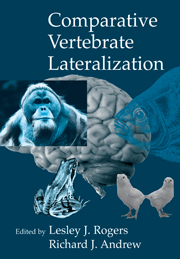Book contents
- Frontmatter
- Contents
- List of Contributors
- Preface
- Introduction
- Part one Evolution of lateralization
- Part two Development of lateralization
- 5 Behavioural development and lateralization
- 6 Factors affecting the development of lateralization in chicks
- 7 Ontogeny of visual asymmetry in pigeons
- 8 Development of laterality and the role of the corpus callosum in rodents and humans
- 9 Posture and laterality in human and non-human primates: Asymmetries in maternal handling and the infant's early motor asymmetries
- Part three Cognition and lateralization
- Part four Lateralization and memory
- Epilogue
- Author Index
- Subject Index
- Richard Andrew
5 - Behavioural development and lateralization
Published online by Cambridge University Press: 10 December 2009
- Frontmatter
- Contents
- List of Contributors
- Preface
- Introduction
- Part one Evolution of lateralization
- Part two Development of lateralization
- 5 Behavioural development and lateralization
- 6 Factors affecting the development of lateralization in chicks
- 7 Ontogeny of visual asymmetry in pigeons
- 8 Development of laterality and the role of the corpus callosum in rodents and humans
- 9 Posture and laterality in human and non-human primates: Asymmetries in maternal handling and the infant's early motor asymmetries
- Part three Cognition and lateralization
- Part four Lateralization and memory
- Epilogue
- Author Index
- Subject Index
- Richard Andrew
Summary
Evidence from the Domestic Chick
Current evidence suggests that, in the domestic chick, lateralization varies along at least three axes: (1) the specialization of left hemisphere (LHem) and right hemisphere (RHem) for perceptual processing; (2) bias to control by one or other hemisphere, which itself may depend on more than one mechanism; and (3) the dominant pattern of interaction between the hemispheres: collaboration or alternation. It will be argued here that, whilst (1) is pre-dominantly established in early development, as a direct consequence of the appearance of the right–left axis of the body, (2) and (3), whilst perhaps initially so established, are subsequently modulated by factors, which can vary between individuals during development. Variation due to such modulating factors can be marked.
Age-dependent Shifts in Standing Bias to Control by One or Other Hemisphere
In the past there has been considerable interest in the possibility that in humans there may be individual differences in the likelihood that RHem or LHem will take charge, independently of effects of task properties. Attempts to find signs of such ‘hemisphericity’ have been discouraging (Boles, 1991), partly because it is difficult to decide how to distinguish a standing bias from effects of learned strategies (which themselves might be affected by an earlier period of bias, now over, or be generated in some other way).
- Type
- Chapter
- Information
- Comparative Vertebrate Lateralization , pp. 157 - 205Publisher: Cambridge University PressPrint publication year: 2002
- 14
- Cited by



